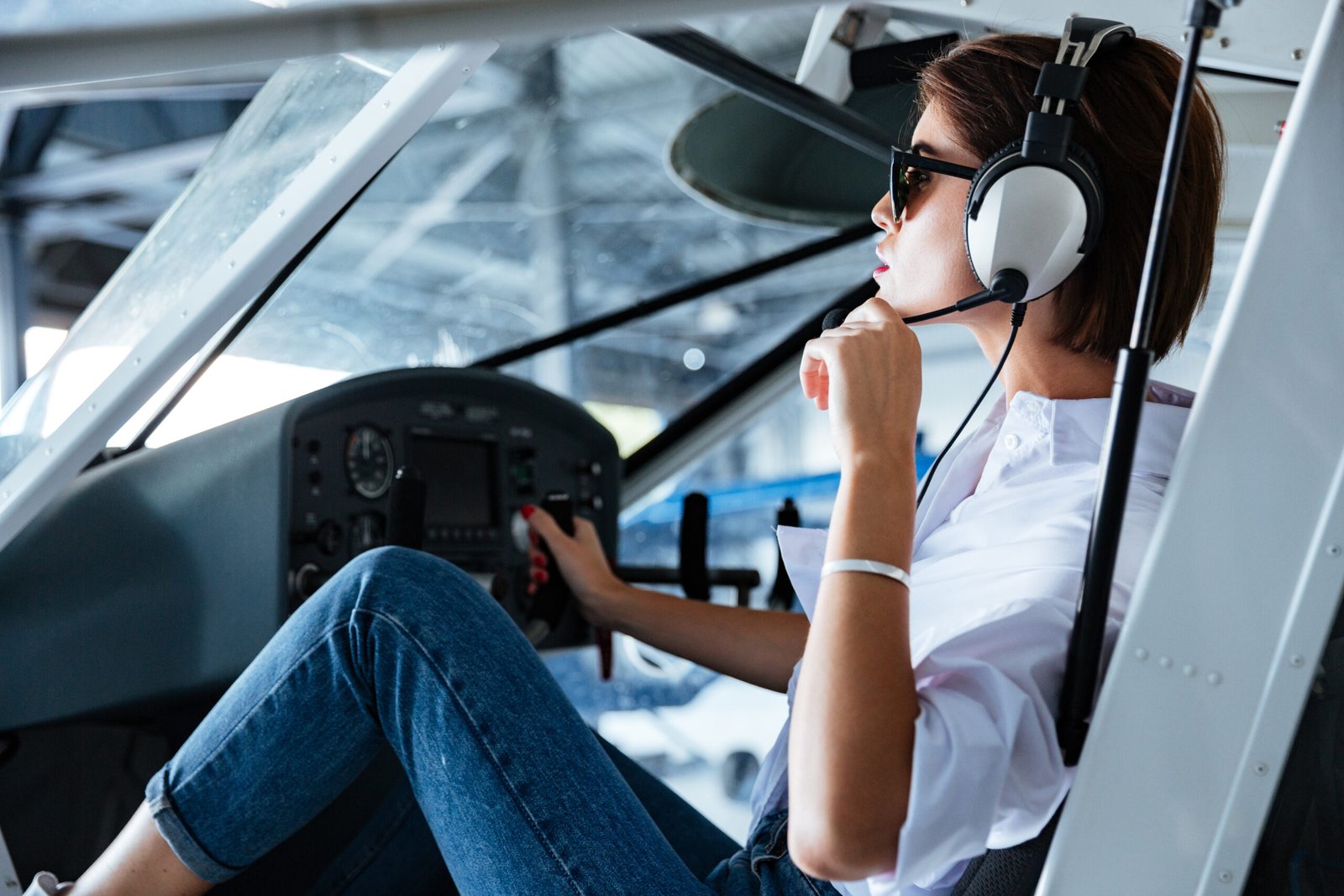Aviation Social Media
From Propellers to Jets: A Journey Through Aviation History
The history of aviation is a remarkable tapestry woven from innovation, determination, and the innate human desire to conquer the skies. From the first wood-and-canvas biplanes that sputtered across fields to the sleek, high-speed jets soaring at 30,000 feet, aviation has evolved dramatically over the decades. This evolution continues today with an array of educational pathways for aspiring aviators and enthusiasts alike.
When it comes to pursuing a career in aviation, several types of courses are available at various aviation schools. For those captivated by the mechanics of flight, there are programs specializing in aircraft maintenance and engineering. These courses delve into aerodynamics, propulsion systems, and avionics—essential knowledge for keeping aircraft safe and operational.
For future pilots, flight training is paramount. Many schools offer private pilot licenses (PPL), instrument ratings (IR), commercial pilot licenses (CPL), and even airline transport pilot (ATP) certifications. Each course builds on practical skills and theoretical knowledge needed for safe navigation through diverse flying conditions. Additionally, specialized instruction in areas like helicopter piloting or glider operation provides niche opportunities for those looking to diversify their skill set.
Moreover, universities often integrate aviation management programs that combine business principles with aviation regulations, preparing students for leadership roles within airlines or airport operations. With such a wide range of options available, prospective students can tailor their education according to their passions within this dynamic field.
As one embarks on this journey through aviation education, staying informed about industry trends and insights is crucial. Fortunately, numerous blogs and websites cater to both professionals and enthusiasts alike. Some notable aviation blogs include “AirlineReporter,” which covers news on airlines’ latest innovations; “Flying Magazine,” which offers advice on flying techniques; and “AeroSavvy,” focusing on pilot training resources.
Social media platforms also serve as fantastic conduits for connecting with fellow aviators. On Instagram or Twitter, accounts like @pilotlife showcase breathtaking aerial snapshots while providing relatable content about daily life as a pilot. Meanwhile, Facebook groups dedicated to specific aircraft models or flying experiences create vibrant online communities where members share tips and stories.
For those seeking formal education or practical experience in flight operations specifically within the United States framework, FAA-approved flight schools are indispensable resources. The FAA maintains rigorous standards ensuring that accredited institutions provide comprehensive training covering all aspects of piloting—from theoretical coursework to hands-on flight experience using state-of-the-art simulators.
These simulation technologies have revolutionized pilot training by offering realistic environments where students can practice maneuvering without risks associated with real-life scenarios. They allow learners to familiarize themselves with cockpit instruments while engaging in emergency procedures under controlled settings—a critical component in building confidence before taking control of actual aircraft.

In summary, from propeller-powered pioneers like the Wright brothers to today’s advanced jets capable of crossing continents swiftly—aviation history is filled with milestones that inspire countless individuals worldwide. By exploring varied educational paths through specialized courses at aviation schools while leveraging contemporary resources like blogs and social media platforms—future aviators are well-equipped not only to understand but also contribute actively to this ever-evolving industry that has captured our imaginations since time immemorial.

Behind the Scenes of Aviation: A Day in the Life of an Airline Pilot
Ever wondered what it’s like to soar through the sky as an airline pilot? The journey begins long before takeoff, often in aviation schools where aspiring pilots gain essential knowledge and skills. These institutions offer a variety of courses tailored to different aspects of aviation. For instance, flight training can be divided into several key areas: private pilot training, instrument rating, commercial pilot certification, and airline transport pilot (ATP) preparation. Each course builds on the last, creating a comprehensive path toward a successful career in aviation.
Private pilot courses focus on foundational flying skills and regulations, allowing students to command small aircraft. As they progress to instrument ratings, they delve deeper into navigation and flying under various weather conditions. The commercial pilot course elevates students from recreational flying to professional standards, while ATP programs sharpen their skills for handling larger aircraft that operate in commercial airspace.
Once equipped with knowledge from these schools, many pilots turn to various online resources for continued learning and community engagement. Blogs and websites dedicated to aviation offer insights into industry trends, personal experiences, and technical advice that can prove invaluable. Some popular sites include Airliners.net for photography enthusiasts and Plane & Pilot Magazine for detailed articles covering everything from technical innovations to safety tips.
Social media platforms have also become vital tools for networking among pilots. Twitter hosts lively discussions about current events affecting aviation; Instagram showcases stunning aerial shots; LinkedIn connects professionals across the industry. Facebook groups create tight-knit communities where members share stories or seek advice—an excellent way for new pilots to learn from seasoned veterans.

However, education doesn’t stop at traditional classroom settings or online forums; FAA-certified flight schools play a significant role in shaping future aviators. These institutions provide hands-on training with experienced instructors who guide students through every aspect of flying—from pre-flight checks to landing procedures. Schools like Embry-Riddle Aeronautical University or Purdue University are renowned for their rigorous programs that emphasize both theoretical knowledge and practical application.
Simulators are another essential component of modern flight training. They allow students to practice various scenarios without leaving the ground—perfectly safe yet incredibly realistic environments where they can hone their skills under pressure. Whether it’s dealing with engine failure or navigating adverse weather conditions, simulators prepare pilots mentally for real-world challenges before they step into the cockpit of an actual aircraft.

As dawn breaks on a typical day in the life of an airline pilot, excitement fills the air—both literally and figuratively! After arriving at the airport early in the morning, pilots conduct thorough pre-flight checks alongside ground crew members. This meticulous attention ensures that every detail is accounted for before embarking on flights that may span thousands of miles.
The cockpit becomes their second home as they communicate with air traffic control while navigating complex routes above bustling cities and sprawling landscapes below them. Every landing represents not just a physical return but also an emotional one—a moment when dedication meets passion high above the clouds.
In conclusion, becoming an airline pilot involves much more than simply sitting behind controls; it requires extensive education through aviation schools offering diverse courses alongside invaluable resources available online today.
With commitment coupled with exploration within this dynamic field—the sky truly is not just a limit but rather a boundless horizon waiting to be discovered!
Sky’s the Limit: Exploring the Most Unusual Airports Around the Globe
When we think about aviation, our minds often conjure images of sleek aircraft slicing through blue skies or bustling terminals filled with eager travelers. However, there’s a whole world beyond conventional airports that captivates the imagination—unusual airports that serve as gateways to adventure and curiosity. While exploring these intriguing hubs, let’s also take a moment to consider how aspiring aviators can prepare for their journeys in this fascinating field.
### Aviation Schools: Charting Your Course
Before you embark on your own airborne adventures, obtaining the right training is crucial. Aviation schools offer a variety of courses tailored to different interests and career goals. Whether you’re dreaming of piloting commercial airliners or managing airport operations, there’s something for everyone:

1. **Pilot Training Programs**: These courses teach aspiring pilots about navigation, meteorology, and flight regulations while providing hands-on flight experience.
2. **Air Traffic Control**: Focused on communication skills and situational awareness, these programs prepare students to manage air traffic effectively.
3. **Aviation Management**: For those interested in the business side of flying, these courses cover airport operations, airline management, and safety protocols.
4. **Aircraft Maintenance Technology**: This program is perfect for individuals who wish to delve into maintaining and repairing aircraft systems.
5. **Flight Dispatching**: Students learn how to plan flights meticulously while ensuring compliance with safety standards.
With such diverse offerings, aspiring aviators have numerous paths available to them!
### Navigating Online Resources
In today’s digital age, staying updated on aviation trends has never been easier. Numerous blogs, websites, and social media platforms cater specifically to aviation enthusiasts:
**Aviation Blogs**:
– *AirlineReporter*: A blog focused on airline reviews and industry news.
– *The Points Guy*: Ideal for frequent flyers looking for tips on maximizing travel rewards.
– *Flying Magazine*: Offers insights into pilot training along with gear reviews.
**Websites**:
– *FlightAware*: Provides real-time flight tracking data.
– *SkyVector*: A fantastic resource for pilots needing sectional charts.
– *AOPA (Aircraft Owners and Pilots Association)*: Great for general aviation news and resources.
**Social Media Sites**:
– Instagram accounts like @aviationdaily showcase stunning aircraft photos from around the globe.
– Twitter users such as @flightradar24 tweet live updates about airline happenings.
These platforms not only keep you informed but also connect you with fellow aviation enthusiasts!
### FAA Flight Schools & Simulators
If you’re ready to take your first steps toward becoming a pilot or enhancing your skills further, FAA-approved flight schools are where you want to be! They provide structured training programs aligned with federal standards. Many offer simulator experiences that allow students to practice flying without ever leaving the ground—a cost-effective way to gain valuable experience before taking off in an actual plane.
Simulators range from basic setups resembling small cockpits to advanced full-motion devices replicating commercial airliner environments. These tools are invaluable; they allow learners to navigate various scenarios safely—from routine operations to emergency situations—without risking lives or equipment.
### Conclusion
As we explore the most unusual airports worldwide—like those perched precariously on mountaintops or surrounded by stunning landscapes—we’re reminded that aviation is much more than just flying; it’s about community engagement and continuous learning. The sky truly is the limit! With quality education options available through various aviation schools and abundant online resources at your fingertips, embracing this exhilarating field has never been more accessible. So whether you’re planning your next trip from an extraordinary airport or gearing up for a career in aviation, remember—the adventure awaits!
Flight Paths: How Aviation Is Shaping a Sustainable Future
As we soar into the future, aviation stands at the crossroads of innovation and sustainability. With a growing emphasis on eco-friendly practices and technology, aspiring aviators can find numerous educational pathways to prepare them for this dynamic industry. Whether you’re interested in becoming a pilot, aircraft mechanic, or air traffic controller, there are various aviation schools that cater to different aspirations.
*Types of Courses Offered in Aviation Schools**
Aviation education is incredibly diverse. At its core, you’ll find programs ranging from traditional flight training to specialized courses:
1. **Pilot Training Programs**: These are designed for those who dream of flying commercial or private planes. From private pilot licenses (PPLs) to airline transport pilot licenses (ATPLs), students learn everything from basic navigation to advanced flight maneuvers.

2. **Aircraft Maintenance and Engineering**: For those fascinated by the mechanics behind flight, these programs teach skills essential for maintaining and repairing aircraft. Students delve into subjects such as aerodynamics, propulsion systems, and aviation regulations.
3. **Aviation Management**: This track focuses on the business side of aviation—ideal for future managers or administrators in airlines or airports. Coursework typically includes operations management, financial analysis, and strategic planning.
4. **Air Traffic Control Training**: Air traffic controllers play a crucial role in ensuring safe takeoffs and landings. Specialized training prepares students for managing airspace effectively while maintaining safety protocols.
5. **Unmanned Aerial Systems (UAS)**: With drones becoming an integral part of both commercial and recreational flying, many schools now offer courses focused on drone piloting and applications.
The variety of options ensures that there’s something for everyone with an interest in aviation!
*Top Aviation Blogs & Websites**
In today’s digital age, staying informed about the latest trends in aviation is easier than ever! Here’s a list of some must-follow blogs and websites:
**Airways Magazine**: Offers news articles covering current events in airlines and airport operations.
**Flying Magazine**: A great resource filled with tips on flying techniques, aircraft reviews, and personal stories from pilots.
**AeroNews Network**: Provides updates on everything from legal changes affecting aviation to new technological advancements.
**FlightAware Blog**: Focuses on global flight tracking—perfect for enthusiasts wanting real-time information.
Social media platforms also serve as invaluable resources:
Join Facebook groups like “General Aviation Pilots” or “Aviation Enthusiasts” where members share experiences and advice.
On Instagram, follow accounts like @aviationdaily that showcase stunning aerial photography alongside industry news.
Twitter handles such as @AvGeekNation often tweet breaking news related to flights around the world.
These platforms foster communities that expand your knowledge while connecting you with fellow aviators!
*FAA Flight Schools & Simulators**
For anyone serious about pursuing a career in aviation within the United States, enrolling in FAA-certified flight schools is essential. These institutions ensure compliance with federal regulations while providing high-quality training environments.
Many schools offer state-of-the-art simulators allowing students to practice in realistic settings before stepping foot into an actual cockpit—an essential tool that enhances safety measures during initial training stages.
Whether you’re looking at local options or renowned institutions like Embry-Riddle Aeronautical University or Purdue University’s School of Aviation Technology—the world is brimming with opportunities tailored specifically for you!
The future of aviation leans towards sustainability—not just through cleaner technologies but through education as well! With various courses available across numerous platforms dedicated to sharing knowledge about this exhilarating field—it’s time to buckle up for an exciting journey ahead!
Soaring High: The Evolution of Aviation Technology Through the Decades
Aviation has come a long way since the Wright brothers took to the skies in 1903. Today, we find ourselves in an era where technology not only enhances flight safety and efficiency but also revolutionizes how we learn about aviation. As we explore the evolution of aviation technology through the decades, it’s essential to look at some of the educational pathways available, valuable online resources, and FAA-certified training options that have shaped aspiring aviators.

### Aviation Schools by Types of Courses
The landscape of aviation education is diverse, catering to various interests and career paths within the industry. From traditional brick-and-mortar institutions to innovative online programs, aspiring pilots and aviation enthusiasts have a plethora of choices:
1. **Pilot Training Programs**: These courses are designed for those eager to take to the skies as private or commercial pilots. They include ground school instruction combined with hands-on flight training.
2. **Aviation Management**: For individuals interested in the business side of aviation, programs focus on airport operations, airline management, and air traffic control systems.
3. **Aircraft Maintenance**: Technical schools offer specialized training for those who wish to work on aircraft systems and structures, emphasizing safety protocols and regulatory compliance.
4. **Avionics Technology**: With advancements in electronic instrumentation in aircraft, avionics programs teach students about navigation systems, communication tools, and troubleshooting techniques.
5. **Unmanned Aerial Systems (UAS)**: As drones gain popularity across various sectors—from agriculture to defense—courses focusing on UAS technology equip students with skills for this burgeoning field.
### Lists of Aviation Blogs, Websites & Social Media Sites
In today’s digital age, staying updated with industry trends is easier than ever thanks to numerous blogs and websites dedicated to aviation. Here’s a curated list worth checking out:
**Airline Reporter**: This blog offers news from behind-the-scenes at airlines along with reviews.
**Flying Magazine**: An excellent resource filled with articles covering tips for pilots and features on new technology.
**The Points Guy (TPG)**: Though primarily focused on travel points and rewards; TPG often includes valuable insights into airline performance.
**AOPA (Aircraft Owners and Pilots Association)**: Provides resources for both novice pilots and seasoned professionals.
On social media platforms like Twitter or Instagram, following accounts such as @JetBlue or @Boeing can provide real-time updates directly from industry leaders.
### FAA Flight Schools/Airplane Schools/Simulators
When it comes to obtaining practical flight experience, FAA-certified schools are paramount. These institutions adhere strictly to regulations ensuring high standards of training:
1. **Part 61 Schools**: Flexible programs allow students to progress at their own pace while working towards their pilot license.
2. **Part 141 Schools**: Structured curricula provide a more regimented approach that may suit those looking for fast-tracked learning experiences.
3. **Flight Simulators**: Advanced simulators mimic real flying conditions without leaving solid ground—these invaluable tools help trainees practice maneuvers safely before entering actual cockpits.
From foundational pilot training courses at local schools to advanced technical studies online or through immersive simulations—aviation education continues evolving alongside technological advancements in aircraft design and operation.
As you reflect on your journey into this fascinating realm where innovation meets tradition—remember that every great flight begins with well-crafted knowledge! Whether you’re planning your first solo flight or just curious about aviation’s rich history—soar high into your dreams!



